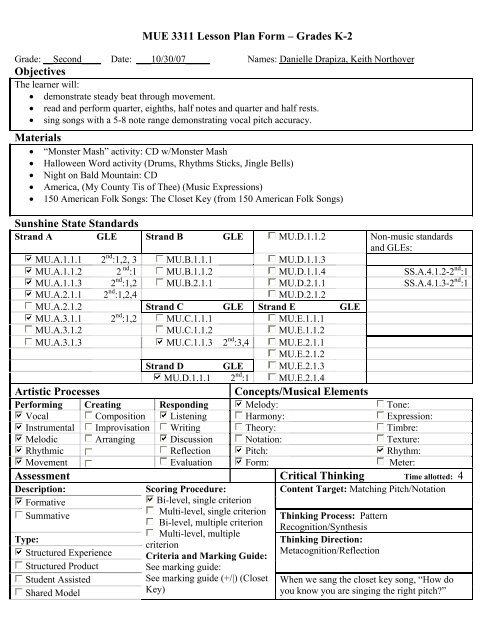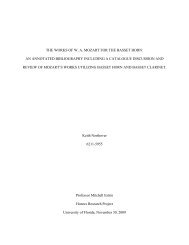Lesson Plan - UF Music Education E-Portfolios
Lesson Plan - UF Music Education E-Portfolios
Lesson Plan - UF Music Education E-Portfolios
Create successful ePaper yourself
Turn your PDF publications into a flip-book with our unique Google optimized e-Paper software.
MUE 3311 <strong>Lesson</strong> <strong>Plan</strong> Form – Grades K-2<br />
Grade: __Second____ Date: ___10/30/07_____ Names: Danielle Drapiza, Keith Northover<br />
Objectives<br />
The learner will:<br />
• demonstrate steady beat through movement.<br />
• read and perform quarter, eighths, half notes and quarter and half rests.<br />
• sing songs with a 5-8 note range demonstrating vocal pitch accuracy.<br />
Materials<br />
• “Monster Mash” activity: CD w/Monster Mash<br />
• Halloween Word activity (Drums, Rhythms Sticks, Jingle Bells)<br />
• Night on Bald Mountain: CD<br />
• America, (My County Tis of Thee) (<strong>Music</strong> Expressions)<br />
• 150 American Folk Songs: The Closet Key (from 150 American Folk Songs)<br />
Sunshine State Standards<br />
Strand A GLE Strand B GLE MU.D.1.1.2 Non-music standards<br />
and GLEs:<br />
MU.A.1.1.1 2 nd :1,2, 3 MU.B.1.1.1 MU.D.1.1.3<br />
MU.A.1.1.2 2 nd :1 MU.B.1.1.2 MU.D.1.1.4 SS.A.4.1.2-2 nd :1<br />
MU.A.1.1.3 2 nd :1,2 MU.B.2.1.1 MU.D.2.1.1 SS.A.4.1.3-2 nd :1<br />
MU.A.2.1.1 2 nd :1,2,4 MU.D.2.1.2<br />
MU.A.2.1.2 Strand C GLE Strand E GLE<br />
MU.A.3.1.1 2 nd :1,2 MU.C.1.1.1 MU.E.1.1.1<br />
MU.A.3.1.2 MU.C.1.1.2 MU.E.1.1.2<br />
MU.A.3.1.3 MU.C.1.1.3 2 nd :3,4 MU.E.2.1.1<br />
MU.E.2.1.2<br />
Strand D GLE MU.E.2.1.3<br />
MU.D.1.1.1 2 nd :1 MU.E.2.1.4<br />
Artistic Processes Concepts/<strong>Music</strong>al Elements<br />
Performing Creating Responding Melody: Tone:<br />
Vocal Composition Listening Harmony: Expression:<br />
Instrumental Improvisation Writing Theory: Timbre:<br />
Melodic Arranging Discussion Notation: Texture:<br />
Rhythmic<br />
Movement<br />
Reflection<br />
Evaluation<br />
Pitch:<br />
Form:<br />
Rhythm:<br />
Meter:<br />
Assessment Critical Thinking Time allotted: 4<br />
Description: Scoring Procedure:<br />
Content Target: Matching Pitch/Notation<br />
Formative<br />
Bi-level, single criterion<br />
Summative<br />
Type:<br />
Structured Experience<br />
Multi-level, single criterion<br />
Bi-level, multiple criterion<br />
Multi-level, multiple<br />
criterion<br />
Criteria and Marking Guide:<br />
Thinking Process: Pattern<br />
Recognition/Synthesis<br />
Thinking Direction:<br />
Metacognition/Reflection<br />
Structured Product See marking guide:<br />
Student Assisted See marking guide (+/|) (Closet When we sang the closet key song, “How do<br />
Shared Model<br />
Key)<br />
you know you are singing the right pitch?”
Include a copy of your<br />
data collection<br />
instrument<br />
What did we learn today? (possible answers:<br />
monster mash, Halloween rhythms, America:<br />
patriotic.<br />
What kinds of notes were used in the rhythm<br />
activity? (Half, Quarter, Eighth)
Accomplished Practices<br />
Instructions: Check (√) the AP you are demonstrating, and bold underline the indicator(s) you are demonstrating.<br />
Assessment<br />
• Uses assessment techniques appropriate to the grade level and<br />
students<br />
• Employs a variety of assessment techniques<br />
• Assesses individual and group musical performance and gives<br />
specific behavioral instruction for improvement<br />
• Assesses learning in a positive, non-threatening manner<br />
• Maintains accurate records of student progress<br />
• Involves students in self-assessment activities at appropriate<br />
intervals<br />
Communication<br />
• Uses correct grammar in speaking and writing<br />
• Instructs students in a clear and understandable manner<br />
• Communicates appropriate musical interpretation verbally<br />
and through conducting gestures<br />
• Communicates purpose and value of music instruction to students,<br />
parents, and other interested persons<br />
• Communicates to students in behavioral terms followed by<br />
concepts as they are learned<br />
Continuous Improvement<br />
• Uses assessment results as a basis for self-improvement in teaching<br />
• Encourages students to value music and to continue involvement in<br />
music beyond the classroom<br />
• Continues to read professional publications and attend workshops<br />
and conferences<br />
• Seeks feedback from students, parents, and other professionals<br />
• Employs reflection as a tool for self-improvement<br />
Critical/Creative Thinking<br />
• Includes opportunities for critical and creative thinking in<br />
learning activities<br />
• Develops musical activities that include composition,<br />
improvisation, and/or arranging<br />
• Involves students in making decisions about the interpretation<br />
of songs and musical works<br />
• Provides opportunities for critical reflection and metacognition<br />
Diversity<br />
• Maintains a classroom atmosphere that respects the differences<br />
among students<br />
• Honors the musical heritage and experiences of all students<br />
• Teaches classes that include appropriate music from a variety of<br />
cultural backgrounds<br />
Ethics/Professionalism<br />
• Demonstrates professional concern for students<br />
• Adheres to relevant code of ethics for music teachers<br />
• Meets expectations regarding attendance, punctuality, and<br />
record keeping<br />
Human Development and Learning<br />
• Selects developmentally appropriate material and activities<br />
• Uses a variety of activities to motivate students<br />
• Seeks to develop both musical skills and useful information about<br />
music<br />
• Develops activities that reflect current theories of musical<br />
development<br />
Knowledge and Presentation of Subject Matter<br />
• Presents all subject matter accurately and musically<br />
• Detects errors in performing music accurately and consistently<br />
• Links instruction to national and state standards, to other<br />
disciplines, and to the students’ lives<br />
• Is able to present subject in a manner meaningful to the students<br />
Learning Environment<br />
• Establishes an active environment for music learning<br />
• Assists students to develop responsibility and self-discipline<br />
• Maintains a positive class or rehearsal room atmosphere,<br />
including the appropriate use of praise<br />
• Focuses instruction on the learning of music by the students<br />
<strong>Plan</strong>ning<br />
• <strong>Plan</strong>s lessons that meet students’ musical interests and needs<br />
• <strong>Plan</strong>s and sequences instruction that leads to the maximum<br />
learning of music<br />
• Includes strategies to accommodate special learners<br />
• Connects subject matter to the Sunshine State Standards<br />
Role of Teacher<br />
• Models appropriate behavior as teacher and musician<br />
• Considers instruction in music as part of the larger educational<br />
effort of the school<br />
• Uses specific directions at appropriate times<br />
• Serves as a guide to students developing musical understandings<br />
and skills<br />
Technology<br />
• Uses learning media, computer applications, and other technology<br />
to enhance instruction in music<br />
• Provides students with appropriate hands-on experiences with<br />
technology in learning music<br />
• Assumes a proactive attitude toward technological<br />
developments in music and music instruction
<strong>Lesson</strong> <strong>Plan</strong> #3<br />
I. Movement Activity: “Monster Mash” (5-8 minutes)<br />
a. Activity Description:<br />
Children will demonstrate steady beat as they learn and perform the motions to the song.<br />
b. Procedure:<br />
Teacher will play music as children enter class room.<br />
Ask the students to think about how a monster moves. Select a few children to demonstrate how they would<br />
walk, move their arms, nod their heads, bend, etc.<br />
Teacher will play music and lead children through motions. (When you hear the music, roam around the room<br />
like a monster, and when the music stops freeze. When the music begins again, you are a new monster) (This<br />
may be repeated depending on time.)<br />
o After activity, ask a few questions to describe the monster voice in the recording, man or woman, high<br />
or low. What kinds of monsters are described in the song?<br />
II. Halloween word rhythms: (8-10 minutes)<br />
a. Activity Description:<br />
Children will perform quarter, eighth, and half notes on different instruments.<br />
b. Procedure:<br />
Teacher will divide children into three groups. Group 1 will use drums, group 2 rhythm sticks, and group three<br />
jingle bells.<br />
Teacher will demonstrate steady quarter notes and speak “pumpkin” on drum to group 1 and have students join.<br />
Teacher will demonstrate “candy corn” eighth note rhythm on sticks to group 2 and have children join.<br />
Teacher will demonstrate “ooooh, ooooh” half note rhythm with bells and have group 3 join.<br />
Teacher will lead group 1 in keeping the beat, followed by the addition of groups 2 and 3 one at a time.<br />
Teacher will have children change groups twice and will repeat the exercise.<br />
Reflection/Discussion: What kinds of notes were used in this exercise? Half Notes, Quarter Notes, Eighth Notes.<br />
III. Movement Activity: “Night on Bald Mountain” (5-8 minutes)<br />
Children will listen to piece and remember feelings associated with piece.<br />
After listening, ask “what kinds of feelings do you feel during the piece, happy, sad? How does the piece end? Could<br />
you create a story to the song? “Possible scenario; Evil Creature and his minions come out during one night and dance<br />
on a mountain peak. At dawn, the ghosts and goblins disappear and the sun comes out.”<br />
IV. Song: “America” (8-10 minutes)<br />
a. Procedure:<br />
Teacher will review song by leading class in echo/ response.<br />
All together, the class will sing the song.<br />
Class will sing “America” with accompaniment CD<br />
V. Closet Key Game (8-10 minutes)<br />
a. Procedure:<br />
Review by singing song through to class.<br />
Have the class join in singing.<br />
Review the rules to the game.<br />
Play game several times and assess students’ pitch accuracy.<br />
VI. Critical Thinking: (3-5 minutes).<br />
“When we sang the closet key song, how do you know you are singing the right notes?”<br />
What did we learn today? (possible answers: monster mash, Halloween rhythms, America: patriotic.



